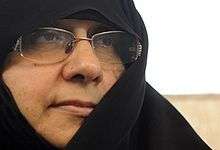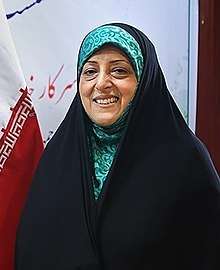Vice Presidency for Women and Family Affairs
Vice Presidency for Women and Family Affairs is a cabinet-level position in Iran, headed by one of the Vice Presidents.
 | |
| Agency overview | |
|---|---|
| Formed | 11 May 2013 |
| Jurisdiction | Islamic Republic of Iran |
| Agency executive |
|
| Website | women |
History
Before the Iranian Revolution in 1979, only a woman served in a similar capacity. Mahnaz Afkhami assumed office as the government minister responsible for women's affairs under administration of Prime Minister Amir-Abbas Hoveyda.[1]
Shahla Habibi was appointed as the head of newly-established 'Bureau of Women's Affairs'[2] and advisor in 1992.[3] Her deputy Masoumeh Ebtekar, was reportedly the "main driving-force" behind the office.[2] The office was renamed to the 'Centre for Women's Participation Affairs' under administration Mohammad Khatami and remained an advisor position, with Zahra Shojaei was appointed as its head.[2] Under Mahmoud Ahmadinejad, the office was renamed to the 'Center for Women and Family Affairs' in 2005, a change that signaled the conservative attitude towards the women.[2] Nasrin Soltankhah, Zohreh Tabibzadeh-Nouri and Maryam Mojtahedzadeh served in the capacity of heading the office until 2013, when the officeholder was promoted to a Vice President.[4]
| Name | Office | Time in office | Appointer |
|---|---|---|---|
| Mahnaz Afkhami | Minister without Portfolio for Women's Affairs | 1976–1978 | Amir-Abbas Hoveyda |
| Shahla Habibi | Bureau of Women's Affairs | 1992–1997 | Akbar Hashemi Rafsanjani |
| Zahra Shojaei | Centre for Women's Participation Affairs | 1998–2005 | Mohammad Khatami |
| Nasrin Soltankhah | Center for Women and Family Affairs | 2005–2006 | Mahmoud Ahmadinejad |
| Zohreh Tabibzadeh-Nouri | 2006–2009 | ||
| Maryam Mojtahedzadeh | 2009–2013 |
Vice Presidents
| No. | Portrait | Name | Term in office | Affiliation | President | ||
|---|---|---|---|---|---|---|---|
| Assumed | Left | ||||||
| 1 |  |
Maryam Mojtahedzadeh | 27 July 2013 | 8 October 2013 | N/A | Mahmoud Ahmadinejad | |
| 2 |  |
Shahindokht Molaverdi | 8 October 2013 | 9 August 2017 | Islamic Iran Participation Front | Hassan Rouhani | |
| 3 |  |
Masoumeh Ebtekar | 9 August 2017 | Incumbent | |||
References
- Karima Bennoune (2013), Your Fatwa Does Not Apply Here: Untold Stories from the Fight Against Muslim Fundamentalism, W. W. Norton & Company, p. 206, ISBN 9780393081589
- Roksana Bahramitash, Hadi Salehi Esfahani, eds. (2011), "From Postrevolution to the Reforms", Veiled Employment: Islamism and the Political Economy of Women’s Employment in Iran, Contemporary Issues in the Middle East, Syracuse University Press, pp. 113–120, ISBN 9780815651192CS1 maint: uses editors parameter (link)
- "Long Overlooked, Iranian Women Bid For Greater Role In Society", Chicago Tribune, 15 March 1992, retrieved 27 August 2017
- Jamileh Kadivar (2016), "Chapter 8: Women and Executive Power", in Tara Povey (ed.), Women, Power and Politics in 21st Century Iran, Routledge, p. 124, ISBN 9781134779895